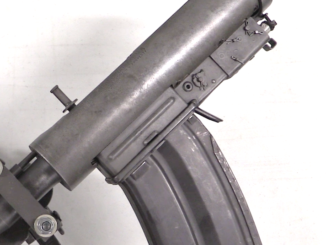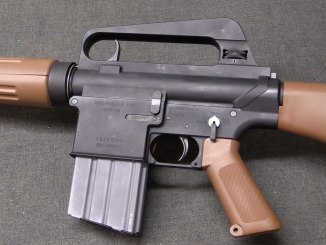In the aftermath of their rejection in the US 1907 pistol trials, Joseph White and Samuel Merrill continued working on handgun designs. In 1911, Merrill wrote to the Ordnance Department to inquire about whether they would be interested in testing his new design. While the Department was willing, Merrill and White never ended up submitting the gun – probably because of a combination of fine-tuning problems and the formal adoption of the Colt/Browning Model 1911 as the new US service pistol.
This 1911 model White-Merrill was a complete mechanical departure from their previous 1907 trials pistol. It uses a delayed blowback mechanism, relying on a heavy mechanical disadvantage when cocking the hammer to delay the opening of the slide. The patent for this pistol (US #1,052,394) describes several different mechanisms for an action that would function equally well without regard to the pressure of the cartridge, but these claims seem dubious to me – rather like the theoretical principle of the Blish lock in the Thompson.
At any rate, it is very interesting to be able to examine the gun – it is the only example made by White and Merrill. Their handguns designs would find no commercial success, but White would go on to submit several interesting rifle designs to compete with the Garand in the late 1920s.




Too late to compete, what a bummer. I doubt that the delayed blowback system would have worked reliably given the limitations of metallurgy and understanding of such at the time. Given a choice, I think the Steyr Hahn would have done a better job than this if chambered for the same ammunition… or am I wrong?
“or am I wrong”
Hard to say, as so far I know, no-one attempted making Steyr-Hahn in .45 Auto, but Obregón is properly working automatic pistol, which is like Steyr-Hahn short-recoil/rotation and fire .45 automatic pistol.
“Their handguns designs would find no commercial success”
I think that there was no place for .45 automatic pistol in U.S. civilian market in 1910s. Can you name any commercially successful .45 automatic pistol sold in USA in 1910s besides Colt Government?
Before about 1919, Colt’s “Military Model” .45, the predecessor of the 12911, was the only self-loader above about .38 caliber for sale in the U.S. The commercial model of the 1911 wasn’t marketed until around 1919-20, and initially Colt’s stock mainly consisted of pistols built for government contracts that were canceled after the Armistice.
As it turned out, Colt still had the civilian market pretty much all to itself. Savage was only making .32s and .380s, Browning was only marketing blowbacks in .25, .32, and .380, S&W’s automatic in .35 was busy failing in the marketplace, and the only other actual locked-breech “major caliber” automatics around were mainly war-surplus P.08 Parabellums and Mauser M1916s, mostly sold by Stoeger. The Spanish-made 9mms and etc. hadn’t really gotten here yet at that time, And Webley & Scott wasn’t selling anything bigger than a .32 in the automatic pistol category, preferring to market their big revolvers.
The result was the nearly-legendary status of the Colt automatics, especially the 1911 .45. This rather overlooked the fact that the 9 x 19mm and .45 ACP cartridges have almost exactly the same effect at the “receiving end”, and that for several years after its introduction in 1926, the most powerful repeating handgun around was the Colt 1911A1 in .38 Super Auto. The .45’s reputation is a bit exaggerated.
cheers
eon
“Browning was only marketing blowbacks in .25, .32, and .380”
I always though that these were Browning-designed but Colt-marketed, am I wrong?
“The .45’s reputation is a bit exaggerated.”
From European’s countries which decides to produce own military automatic pistols before start of WW2, only Norway adopted .45 Auto (as 11,25m/m in weapon known as Colt Kongsberg) and Great Britain adopted similar .455 Webley semi-rimmed cartridge for use in Webley Scott automatic pistol (used in limited numbers), but later in inter-war period switched to .38 as default side-arm caliber.
“The .45’s reputation is a bit exaggerated.”
Also notice that it was answer to U.S. Army requirements – notice that earlier J.M.Browning designed automatic pistols use smaller diameter bullets, for example .38 ACP which in original form was 130gr @ 1260 fps:
https://en.wikipedia.org/wiki/.38_ACP
If I am reading the patent correctly, what White calls a receiver is what we would call the slide. When the gun is fired the breech bolt slides back within the slide until it bears heavily upon the drum of the hammer. As the slide tries to move rearward. it must overcome the mechanical disadvantage of the hammer’s short lever arm upon the frame as well as the friction between the hammer and the breech bolt which prevents the hammer from rotating. When chamber pressure drops hammer rotation is only limited by the mechanical disadvantage.
Pretty much just regular friction. It is harder to slide a couch across the room with three fat guys and a big dog on it, than when they all get off.
Thanks bp. This pistol should work just like as you described. If the hammer is accepted as an accelerator, the approach also be considered as a lever delay mechanism working in reverse direction, that is to close the breech bolt. However, in case of calculating leverage ratios effecting the correct timing, there it would be less than enough remaining gas inside the barrel to accomplish the cycling of the slide.
How it is supposed to work, and whether it works are separate questions. I have the same concerns as you, but there is a lot to tinker with. White was very creative so maybe he got it running.
You could call this a form of lever delayed blowback ?
If largely depends over the given eccentricity of hammer drum but, seemingly, intended function based on the friction or, Mr Joseph C. White might not aware of it or awarded but not mentioned.
correction: if=it, awarded= aware
In several ways, the “locking system” of this pistol seems to have been inspired by the Remington-Rider “rolling block” single-shot breech, in that the hammer acts as part of the locking system.
The difference is of course that on the rolling block, the breast of the hammer underneath the actual breechblock prevents the breechblock from rotating backward until the hammer has been manually recocked. Here, the backward movement of the hammer is caused by the breechblock recoiling over it after first overcoming the friction between the hammer “tail” and the ledge in the frame.
How “retarded” the blowback on this action is literally depends on the strength of the hammer spring, essentially acting as a second, supplementary recoil spring.
cheers
eon
I don’t know that hammer fired blowbacks are considered lever delayed, but the result is roughly the same. By varying hammer spring rate and the lever arm between the hammer axis pin and where the slide (usually, but not in this case because it is a slide mounted hammer) makes contact with the hammer you can increase the delay by making the hammer harder to cock. If there is no additional lever, I don’t know if lever delayed is correct and would add to confusion. Perhaps “hammer cocking delayed blowback”.
Mr.White would probably disagree though, the sliding breech bolt within the slide acts a connecting rod between the piston (cartridge case) and the brake shoe stopping hammer rotation, that is the rear end of the breech bolt bears heavily on the hammer, keeping it fixed. Once chamber pressure drops, the brake is released and it becomes a “hammer cocking delayed blowback”. Just my 2 cents.
“Lever Delay” generaly refers to a two piece breechbolt, one mounted in another and a frame supported lever transmitting the certain amount of momentum from the one standing against the fired case to another with an ascending leverage ratio through which speeding up the same, and by means, slowing the other. Generaly the speeding unit contains bigger mass for wasting larger amount of momentum and therefore, remaining lesser amount for the smaller, hoped to slow unit. If a hammer transmits its gained momentum to another recoiling unit in ascending ratio, it should be accepted as an accerelator and the combined unit as a delay mechanism. But in common hammer guns this is not present and the accerrelation effect of hammer generaly is wasted. But in this prototype, there presents a two piece breech closure element and in case of the slide mounted hammer having an eccentricity with ascending radius via rotation, it speeds up the real breechbolt to the forward, to the reverse direction compared to usual, and provides more than over enough delay for breechbolt opening but may cause to waste all remaining gas and backward gained momentum needing to cycle the feeding mechanism. radius of even running of hammer drum may stand still the breechbolt for a while to collect the needed backward thrust and smaller contact area would rise it and the descending radius of hammer drum would insure the correct intention. IMHO.
I think that the breech bolt moves very slightly and over a very short time span that the slide can be treated as a a single piece even while chamber pressure is rising. Moving a couple thousandths over a small fraction of a millisecond provides negligible delay. The locking comes from preventing hammer rotation because the breech bolt alone interferes with the hammer.
Sure it is. Most of my thoughts are possible alternatives usable through this gun`s construction. In fact, possible speed changing recoiling element being opposite than usual, the lesser massed, first fired case thrust taking unit.